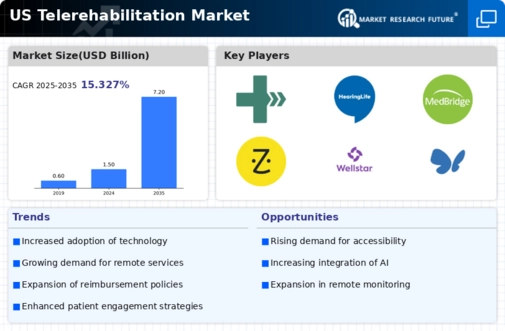The US Telerehabilitation Market has witnessed significant growth in recent years, driven by advancements in technology, increasing healthcare costs, and a growing emphasis on patient-centered care. Telehealth, including telerehabilitation, allows healthcare providers to deliver services remotely, ensuring that patients have access to care regardless of geographical barriers.
The market landscape is rapidly evolving, characterized by various players including software providers, healthcare institutions, and technology firms. Companies within this market face the continuous challenge of staying ahead of technological advancements while also complying with regulatory requirements.
Competitive insights reveal that businesses must not only focus on innovative solutions that enhance patient outcomes but also cultivate partnerships and improve service delivery models to maintain a competitive edge.
Physitrack has established a strong presence in the US Telerehabilitation Market by offering a comprehensive platform that empowers healthcare providers to engage with patients through digital therapy programs. The company excels in delivering patient education videos, exercise programs, and progress tracking tools that enable continuous interaction and better clinical outcomes.
One of the key strengths of Physitrack lies in its user-friendly interface and diverse content library, which enriches the patient experience while providing healthcare professionals with effective tools for treatment management. The organization's emphasis on data analytics also allows providers to monitor patient progress closely and make necessary adjustments to treatment plans, significantly contributing to patient satisfaction and adherence to therapy.
Hearing Life, specializing in audiology solutions, has made strides in the US Telerehabilitation Market by combining advanced technology with telehealth services aimed at improving auditory rehabilitation. Their offerings include comprehensive audiological assessments, personalized rehabilitation programs, and ongoing patient support through digital platforms.
Hearing Life's market presence is reinforced by its commitment to leveraging innovation in hearing aid technology as well as remote patient monitoring systems, enhancing accessibility and convenience for patients. The company has also pursued strategic mergers and acquisitions to expand its foothold within the telerehabilitation sphere, ensuring a robust network of services designed to cater to the specific needs of individuals with hearing impairments.
By focusing on tailored care solutions and integrating state-of-the-art technology, Hearing Life solidifies its position within the competitive landscape of US telerehabilitation, setting it apart in an increasingly digital health environment.


























Leave a Comment